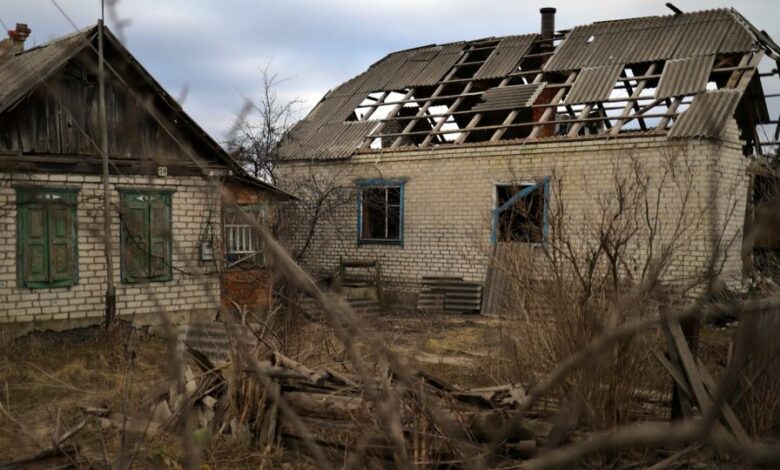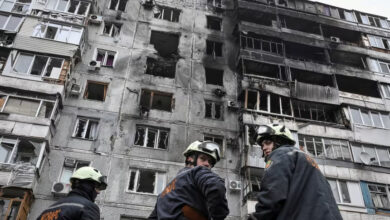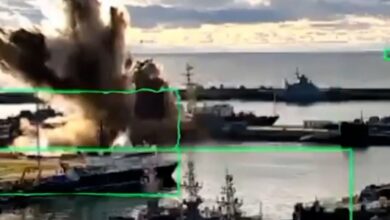
Ukrainian and Russian forces have been fighting here for nearly two months. If the Ukrainians can break through Russian lines and reach Kreminna, they can disrupt Russian supply routes.
But it’s a much tougher proposition than it was at the end of last year. Russia’s defensive lines have been reinforced with heavy weapons and long-range artillery.
CNN accompanied two Ukrainian drone operators from the Dnipro-1 battalion deep into the forest to see how they operate. The journey was along tracks of soft sand amid a thin canopy of pine trees, through an eerie landscape dotted with streams and bogs.
A year ago, one of the drone operators, who gave his name only as Ruslan, was a snowboard and kayak instructor. Now he’s watching the movement of Russian armor along the forest tracks, expertly skimming his drone across the treetops.
Arriving at a foxhole, the drone operators’ vehicles are carefully maneuvered under tree cover. The Russians have reconnaissance drones too, and Ukrainian drone operators are regarded as high-value targets.
Ruslan points to the east and north: the Russians were 7 kilometers (4 miles) away in one direction and 3 kilometers in the other.
A Mavic-3 drone – the workhorse of Ukrainian reconnaissance, even if it weighs less than a kilogram and has a span of just 35 centimeters (14 inches) – ascends with a whir from a nearby clearing. It can remain aloft for about 45 minutes and travel up to 30 kilometers in total, feeding high-definition video back to the operators.
Their job is to provide real-time intelligence on Russian positions and movements, and also to help Ukrainian artillery fix targets. Hidden among the woods are emplacements of 120mm and 82mm artillery, and somewhere nearby a massive Krab 155 mm howitzer, one of about 50 donated by Poland. The Ukrainians like the Krab for its accuracy and power, but it is demanding to maintain.
“This is artillery battle all day,” Ruslan says.

He’s not exaggerating. There are few moments of silence during the hour CNN is with Ruslan and his colleague. Artillery shells launched from a nearby Ukrainian emplacement make a deafening roar. The crump of Russian shelling echoes in the distance.
“The last month, the Russian army are here more and more,” Ruslan says. “The overall line is static but all the time the positions change. Sometimes the Russians go (forward) and sometimes our army goes.”
That means firefights in the thick of the forest. But it also means that Ukraine is getting through its artillery munitions fast. Trucks rumble through the nearby village of Yampil with fresh supplies, but Ruslan says Ukraine needs much more artillery ammunition here.
In the nearby village of Zarichne, just beyond the forest fringe, Russian artillery targets a rickety bridge every day. There is not much of the village left standing: Those remaining here are mainly the elderly and the destitute. They either can’t or won’t leave.
One of them – a 69-year-old who gives her name as Valentina – tells CNN the Russians shell the village all the time.
“It is dangerous but what can we do? We endure. Sometimes we hide. But now it is too cold in the basement, you can freeze to death there,” she says.
“Look at my windows, there is no glass remaining. Just wood and plastic we used to cover them. And it’s cold.”
She looks down the street wistfully, as if remembering better times.
Valentina’s daughter is far away in Dnipro, central Ukraine, but she won’t quit her home to join her. After all, she has planted potatoes. “I won’t abandon them,” she says with a tired smile.
Zarichne – like large swathes of this region – was occupied by the Russians for much of last year before being liberated by Ukrainian forces in the fall. But liberation came in name only. The slopes and forests beyond echo to the impact of rockets and shells. Ukrainian units are dug in among the pines and sand nearby, where unexploded ordnance litters the forest floor.

A few miles away, the Dnipro-1 battalion has its own drone workshop, where NATO-issue grenades are carefully sawn in half to be reconstituted as small, free-fall munitions. Under a table sits a slab of C-4 plastic explosive. It’s a painstaking and demanding process, churning out one a handmade munition every 20 minutes.
Some of the unit’s drone munitions are essentially fragment grenades dropped on infantry – and especially fighters from the Russian private military contractor Wagner fighters around Bakhmut. Heavier versions can damage or disable a tank.
The commander of Dnipro-1’s drone unit goes by the name of Graf. He says that drones have become “one of the most important elements of this war – both for us and the enemy. Nothing can be executed without drones.”
And that makes his men targets. “At the moment the drone operator is one of the most dangerous jobs. The enemy knows we are the eyes of our army. As soon as they locate a drone operator, they use all kinds of weaponry: barrel artillery, MLRS, tanks,” Graf says.
“We have high rate of casualties among the pilots, the enemy is always looking for us.” Graf says.
No Ukrainian soldier on this front is under the illusion that this conflict will be won soon. Across the eastern Donbas region, brutal, attritional battles are unfolding: Gains and losses are measured in hundreds of meters.
Graf echoes what every Ukrainian soldier says seems to say. “Now we are receiving tanks – so we need more tanks. And we need aviation and long-range missiles. We have to destroy the enemy on its approach to Ukraine. That’s the only way to win.”
And for his unit, Graf dreams of getting US Predator attack drones. That’s not under consideration in Washington, DC.
In the meantime, Ruslan and his colleagues hold the line – and in Zarichne, Valentina prays for them.
“God damn those Russians coming to other people’s land!” she says. “I stand for Ukraine, I was born here, my ancestors are from here, I always was pro-Ukraine and always will be.”




